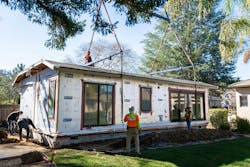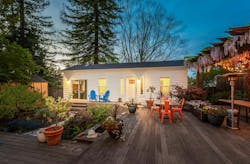Prefab Plus Infill: A Formula for Homes People Can Afford in Places They Want to Live
When we think of building new homes, we might conjure up images of massive tracts of land being cleared for large developments with new roads, new sidewalks, and new utility lines. But infill housing—building homes on lots within already established neighborhoods—is an often-underappreciated opportunity. And it’s an opportunity that California-based Villa Homes is tapping, says Sean Roberts, CEO.
Villa Homes provides infill housing with prefabricated volumetric construction. In April, Villa Homes was named one of the top 10 finalists for the prestigious Ivory Prize. “Villa is creating a scalable solution that can meet the needs for more attainable housing production across America,” Ivory Innovations stated.
“There’s a shortage of smaller, entry-level housing that people can afford,” Roberts says. Villa Homes fills that need by targeting “the classic missing-piano-key lots that don’t have homes on them and need to be redeveloped with greater density.”
Villa Homes: Prefab Infill Housing
Villa’s homes span from accessory dwelling units (ADUs) to single-family homes to multifamily complexes. “All this housing can be and should be built in infill locations in high-cost housing markets,” Roberts says.
Infill housing offers proximity to schools and jobs, as well as existing roads and utilities, which puts less burden on local governments and utility providers. “So we can have housing for people in locations where they want to live, work, and go to school,” Roberts says.
According to Roberts, Villa’s focus on infill has been enabled in recent years by zoning and other policy changes that allow single-family lots to be divided into smaller lots for more, and more affordable, housing.
Like other builders of prefabricated homes, Roberts touts prefab’s lower costs, faster construction times, reduced labor needs, and fewer onsite risks such as weather.
But unlike other prefab builders, Villa doesn’t own any factories. Instead, Villa contracts third-party manufacturers to produce Villa’s homes with its proprietary designs on a white-label basis.
By taking this approach, Roberts explains, Villa avoids the large capital costs of building and running its own manufacturing facilities. And it can work with geographically dispersed factories closer to its sites, which reduces the cost of transporting the modules. As a result, Villa gains a more flexible and scalable supply chain.
Manufacturing Process for Prefab Homes
While its manufacturing partners build the modules in their factories, Villa saves time by working in parallel to get the site ready—for instance, by preparing the foundation. Once the modules arrive, Villa quickly takes care of the finishing work, such as closing up the walls and roofs and connecting the utilities.
“We can be comfortably in and out of a site in three or four months and sometimes a whole lot faster,” depending on factors such as inspections, Roberts says. He compares those few months to the 12-plus months that a site-built home can take—with that much more time for developers and owners to carry construction loans. “That speed plays directly into the cost of the project,” he says.
Villa’s wood-frame, modular homes are built to be Energy Star compliant and solar ready and feature modern appliances and finishes, such as Shaker cabinets. That said, “this isn’t the peak of luxury housing,” Roberts says. “We’re the Toyota of housing: It works really well, it’s durable, and it’s high quality for the money.” He says Villa delivers homes below the cost of traditional site-built homes.
Founded in 2019, Villa Homes started out by building ADUs in the backyards of single-family homes in California. For over a year now, Villa has expanded into other areas of building, such as ADUs alongside multifamily complexes, in addition to entry-level single-family homes. “There’s a massive need for smaller entry-level homes that have been undersupplied for the past 25 years,” Robert says.
The ADUs range from studios to three bedrooms, and from 440sf to 1,200sf. The entry-level homes range from two to three bedrooms and 900sf to 1,200sf. Most recently, Villa has been building two-story, 1,600-sf homes and attached townhomes. Villa’s customers include individuals, local developers, and institutional investors.
So far, Villa has built its ADUs and homes in California. The company plans to start building in Colorado in the second half of this year. As it grows, Villa will continue to target “high-cost, land-constrained, and trade-constrained markets,” Roberts says.
Still, Villa’s innovative approach requires some education of stakeholders, Roberts finds. “There’s a voracious demand in this country for affordable, attainable housing—the demand is there for days,” he says. “But getting investors, lenders, and other folks in the ecosystem to be comfortable with applying prefab applications where it hasn’t been used before takes a bit of education.”



